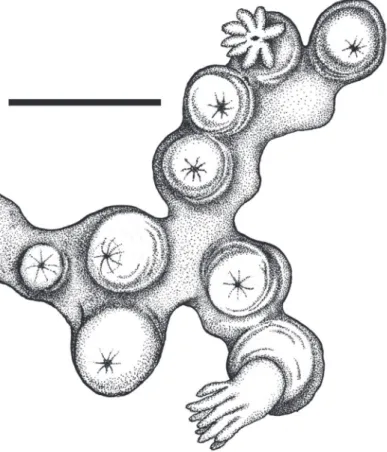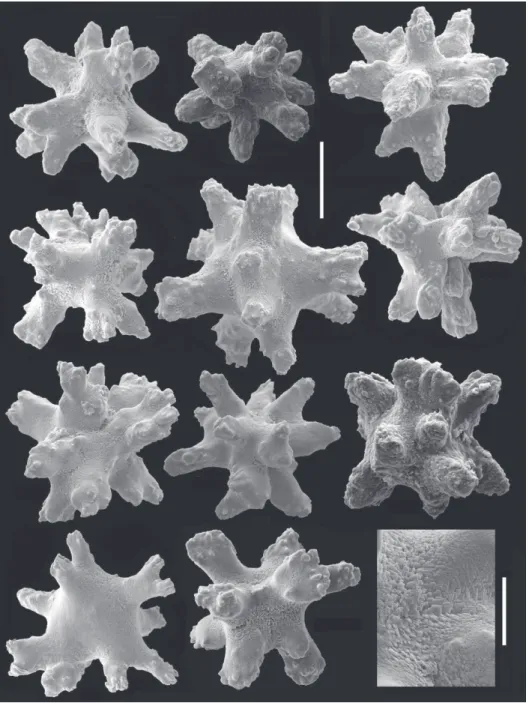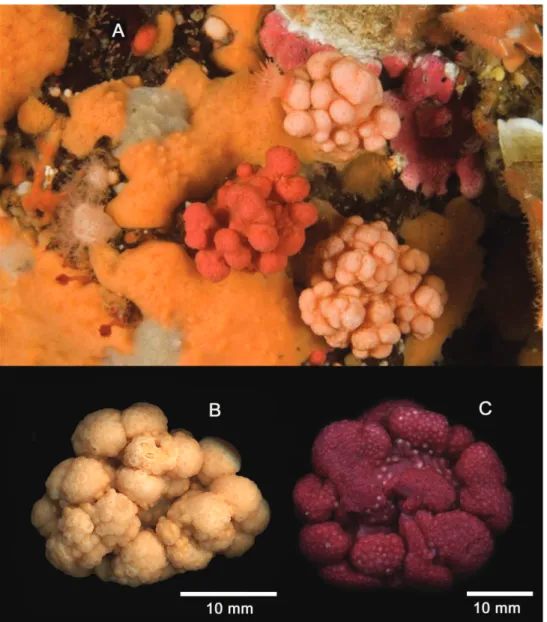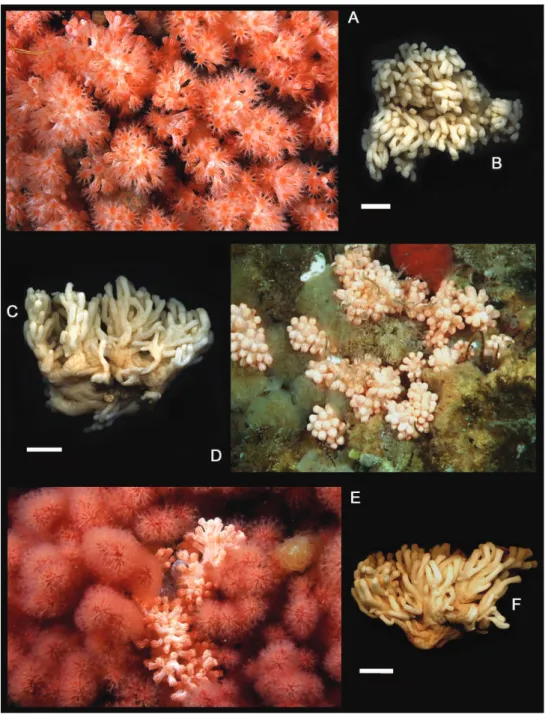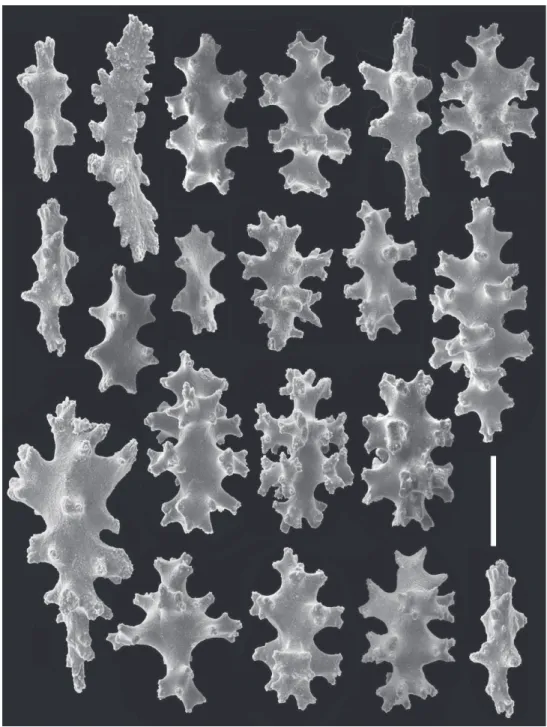New taxa and revisionary systematics of alcyonacean
octocorals from the Pacific coast of North America
(Cnidaria, Anthozoa)
Gary C. Williams1,†
1 Department of Invertebrate Zoology and Geology, California Academy of Sciences, 55 Music Concourse Dri-ve, San Francisco, California, 94118, USA
† urn:lsid:zoobank.org:pub:B988C1E1-7D0A-44E1-9E7D-766D2CEC9079
Corresponding author:Gary C. Williams (gwilliams@calacademy.org)
Academic editor:B.W. Hoeksema | Received 4 February 2013 | Accepted 8 March 2013 | Published 3 April 2013
urn:lsid:zoobank.org:author:4BD094B7-F9C6-4FB5-89F4-3BAAFF46DD96
Citation: Williams GC (2013) New taxa and revisionary systematics of alcyonacean octocorals from the Paciic coast of North America (Cnidaria, Anthozoa). ZooKeys 283: 15–42. doi: 10.3897/zookeys.283.4803
Abstract
A taxonomic assessment of four species of octocorals from the northeastern Paciic Ocean (British Colum-bia to California) is provided. Included here are a new species of clavulariid stoloniieran Cryptophyton, a new species of the nephtheid soft coral Gersemia, an undetermined species of soft coral in the genus Alcyonium that has been referred in the literature by several other names, and a new genus is named for a plexaurid sea fan originally described in the Indo-Paciic genus Euplexaura. Discussions are included that compare the species to related taxa, or provide revisionary assessments.
Keywords
Alcyonium, Cryptophyton, Gersemia, Octocorallia, northeastern Paciic, plexaurid gorgonian, soft corals, taxonomy
Introduction
Bayer (1981a: 7–9) reviewed the present status of knowledge of octocorals in the major geographical regions of the world and established four categories representing broad levels of taxonomic knowledge – essentially complete, moderately well-known, poorly
www.zookeys.org
Copyright Gary C. Williams. This is an open access article distributed under the terms of the Creative Commons Attribution License 3.0 (CC-BY), which permits unrestricted use, distribution, and reproduction in any medium, provided the original author and source are credited.
known, and minimally known. He regarded the geographic region of the western coast of the Americas south to the Gulf of Panama as, “Moderately well-known: where there is extensive literature, but many more species remain to be described and taxonomic problems to be solved, and the major patterns of distribution must yet be worked out. Much descriptive work remains to be done before ecological and experimental stud-ies can proceed at an efective level.” In spite of this, he lists a paucity of works in the literature – only ive articles that treat the fauna, three of which cover tropical Central America (from the Gulf of California to Panama), while only two treat California – Nutting (1909) and Kükenthal (1913). he coasts of Oregon, Washington, and British Columbia are for the most part absent from the taxonomic literature. he calcaxonian octocorals of the eastern Paciic were treated by Cairns (2007) and the book chapter of Williams (2007) dealing with shallow water octocorals of the region, were added sub-sequently. hese four works taken together, amount to the most inclusive taxonomic treatment to date of the west coast North American octocorals.
Recently collected material from British Columbia and California has allowed for the examination and taxonomic assessment of several shallow-water soft corals (inter-tidal to 20 meters in depth), as well as a plexaurid gorgonian (32-85 m).
Materials and methods
All material examined is housed in the marine invertebrate collections of the California Academy of Sciences, preserved in 95% ethanol, and acquired from various sources. Scanning electron micrographs were made using a LEO 1450 VP SEM.
Material used for comparative purposes: Euplexaura sp., CAS 107595, Western Paciic Ocean, Palau, Neco Channel, 28 September 1996, 24 m depth, coll. Gary C. Williams, one whole specimen.
Abbreviation used in the text: CAS (California Academy of Sciences, San Francisco).
systematic account
Order Alcyonacea Lamouroux, 1816 Family Clavulariidae Hickson, 1894 Genus Cryptophyton Williams, 2000
Cryptophyton jedsmithi sp. n.
urn:lsid:zoobank.org:act:482B9A4A-2E2E-4A4A-A319-5CC211242B45 http://species-id.net/wiki/Cryptophyton_jedsmithi
Figures 1–4, 19
transverse platforms absent. Anthocodial armature absent. Sclerites of stolons and an-thosteles 0.06–0.10 mm in diameter, mostly spiny balls or stellate bodies with project-ing processes in three dimensions.
Type material. Holotype. CAS 177194. North America, U.S.A., California, San Diego County, San Diego, Point Loma, 32°42'N, 117°15'20"W, 12 February 2006, collector: Jef Goddard, one specimen wet-preserved in 95% ethanol.
Habitat and distribution (Figure 19): Under a boulder in the low rocky intertidal zone at the type locality.
Etymology. he species is named for Jedediah Strong Smith, American trailblazer and cartographer, who explored vast regions of western North America between 1822 and 1831, and along the Paciic Coast, including San Diego in December of 1826 (Brooks 1977) – the area of the type locality of the new species.
Description. Colonial morphology (Figures 1A, 2). he holotype consists of ap-proximately eighty-ive polyps arising from lattened basal stolons. he stolons en-crust a piece of dead cheilostomatid bryozoan, 32 mm long by 20 mm wide. he surface of the bryozoan is interspersed with several calcareous tubes of a serpulid polychaete.
Polyps (Figures 1B–C). Anthosteles are moundlike, rounded, hemispherical to
few are emergent. he anthosteles are approximately equal in height and diameter, mostly 1–1.4 mm.
Sclerites (Figures 1D–E, 3, 4). Sclerites of the coenencyme and anthosteles
resem-ble spiny balls or stellate bodies with projecting processes in three dimensions; 0.05 – 0.10 mm long. Sclerites are absent from the anthocodiae and polyp bodies.
Color (Figures 1A–C). Color in life: the anthosteles are pale orange and the an-thocodiae are white. Wet-preserved holotype: stolons and anthosteles light grayish white, while the emergent anthocodiae are white.
Diferential diagnosis. Two species of the genus Cryptophyton are known,
Cryp-tophyton goddardi Williams, 2000 and C. jedsmithi sp. n. he two species difer in
sclerite shape. hose of C. goddardi are irregularly-shaped radiates, tuberculated rods, and shuttles (Williams 2000: 337), while those of C. jedsmithi sp. n. mostly resemble spiny balls or stellate bodies (Figures 1D–E, 3–4).
he geographic range of Cryptophyton goddardi was originally known only from the type locality of central Oregon on the Paciic Coast of the United States, but has recently been extended southwards to southern California, and has been collected at seven locations (Figure 19), while C. jedsmithi sp. n. is known only from the type local-ity – San Diego, California (Figure 19).
Key to the species of Cryptophyton
1a Anthosteles (polyp mounds) cylindrical, up to 2.8 mm in height and 1.8 mm in diameter. Sclerites are irregulary-shaped radiates, irregular sclerites presumably derived from radiates, tuberculate rods, and shuttles; 0.06–0.18 mm long ...Cryptophyton goddardi 1b Anthosteles (polyp mounds) hemispherical, approximately equal in height
and diameter, mostly 1–1.4 mm. Sclerites resemble spiny balls or stellate bodies with projecting processes in three dimensions; 0.05–0.10 mm long ... ...Cryptophyton jedsmithi sp. n.
Family Alcyoniidae Lamouroux, 1812 Genus Alcyonium Linnaeus, 1758
Alcyonium sp. indet. Figures 5–6
Synonomy. Alcyonium sp. Williams (2007: 184-185, 188); Williams and Lundsten (2009: 1078).
Material examined. CAS 179450, Canada, British Columbia, Weynton Passage, Plumper Group of islands, Plumper Island, (50°35.501'N, 126°47.997'W), 20 m depth, 10 November 2009, collector: N. McDaniel, one whole colony. CAS 173217, Canada, British Columbia, Strait of Juan de Fuca, Swordish Island (48°18'36.4"N, 123°34'58.4"W), 6 m depth, 28 September 2009, collectors: C. Blondeau, T. Hill, R. Van Hall, one whole colony, abundant in underwater tunnel with dynamic surge. CAS 029138, U.S.A., Alaska, Arctic Ocean, near Point Barrow, 44 m depth, 29 July 1951, collector: J. Bohlke on R/V ”Ivik”, two whole colonies.
zoophytes and corals between 1766 and 1798 (Bayer 1981a). Ehrenberg also notes the locality of Lobularia rubiformis as “Mari septentrionali” (= Northern Sea). Needless-to-say, this is ambiguous and could serve to describe the North Atlantic, the Arctic Ocean, or all northern seas including the North Paciic. he name Gersemia rubiformis
North Paciic Ocean from Alaska south to California and west to Russia (Williams et al. 1987; Ofwegen 2012b).
In addition, there are other ambiguous details that are relevant here. Ehrenberg’s 1834 paper is dedicated to the corals of the Red Sea, but he lists Lobularia rubiformis as inhabit-ing the “Mari septentrionali.” he genus Lobularia is a synonym of Cladiella, a zooxanthel-late Indo-Paciic genus that is distributed in the Red Sea as well as much of the Indo-West Paciic (Fabricius and Alderslade 2001). he genera to which this species has been identi-ied in the literature represent two diferent soft coral families, the Alcyoniidae and the Nephtheidae. My examination of western North American material reveals that the species has small, completely retractile polyps and a polyp arrangement that is lobate rather than catkin-like (even though there may be few to no polyps on the lower parts of the expanded lobes). In addition, the northeastern Paciic material (Figure 5) exhibits morphological similarities to other species of Alcyonium, as previously described and illustrated (Verseveldt and Ofwegen 1992; Casas et al. 1997; Ofwegen et al. 2007). he general appearance of the scIerites of Alcyonium sp. indet. (Figure 6) are consistent with other species of the genus as well. I therefore here align the species to the Alcyoniidae, rather than the Nephtheidae.
Recent molecular phylogenetic evidence shows that there are two species included
in Gersemia that nest in the genus Alcyonium, rather than with other nephtheids (Breedy
et al. 2012: 357). In light of this, future research may show that other species previously allocated to Gersemia may in fact belong to Alcyonium. It is not known if a type speci-men of Lobularia rubiformis was ever designated. From the aforementioned, it is here considered that the Paciic coast material cannot justiiably be ascribed to Gersemia
rubi-formis and the validity of that species cannot be determined at present. Because of this,
the Paciic coast species is considered as an unidentiied species of the genus Alcyonium
Williams 2007: 184-185, 188; Williams and Lundsten 2009: 1078). It is evident that a taxonomic revision and determination of the validity of Gersemia rubiformis is necessary, and that molecular studies of samples from various populations in the Atlantic, Arctic, and Paciic Oceans may provide a clearer understanding regarding taxonomic status.
Family Nephtheidae Gray, 1862 Genus Gersemia Marenzeller, 1878
Gersemia lambi sp. n.
urn:lsid:zoobank.org:act:C2BFCF41-3F55-43FA-9858-9FFC2543E0ED http://species-id.net/wiki/Gersemia_lambi
Figures 7–11, 19
Figure 10.Gersemia lambi sp. n. Scanning electron micrographs of stalk sclerites. Scale bar = 0.04 mm.
Type material. Holotype. CAS 171939, Canada, British Columbia, Langara Is-land; 26 June 2004; 12 m depth, collected by Andy Lamb; one specimen. Paratypes. CAS 171940, same data as holotype, one specimen. CAS 171940, same data as holo-type, one specimen.
Figure 11.Gersemia lambi sp. n. Scanning electron micrographs of stalk sclerites. Scale bar = 0.04 mm.
Queen Charlotte Island; 9 m depth, 51 54.624'N, 130 58.635'N; 7 August 2003; 20 m depth; collected by Doug Swanston; one specimen. CAS 173219. Canada, British Columbia, Queen Charlotte Islands, Kunghit Island, west side of Cape St. James; 21 May 2002; 9 m depth; collected by Danny Kent; one specimen.
Etymology. his species is named for marine naturalist and educator Andy Lamb (Vancouver, British Columbia), who collected the type material.
Description.Colonial morphology (Figures 7B-C). he holotype measures 55 mm in length, 39 mm in width, and 35 mm in height. It is composed of dense concentra-tions of autozooids distributed in isolated clusters on several lobes that emanate from the stalk, which arises immediately above the basal holdfast. Each cluster usually con-tains approximately 5 and 15 polyps.
Polyps (Figures 7B–C,F). he polyps are monomorphic, non-retractile, tubular
in shape, and vary in length and width (4.0–7.0 mm in length and 1.5–2.0 mm in width). he width of the polyps is greatest at the distal extremities. he polyps are erect and often curve upward from their bases.
Sclerites (Figures 8–11). Coenenchymal sclerites of the polypary are primarily
sharp-ly-tuberculated radiates, 0.03–0.11 mm. Coenenchymal sclerites of the stalk are mostly variously-ornamented radiates and modiied radiates, 0.03–0.12 mm long. Polyp wall sclerites abundant, uniformly and densely-distributed, 0.03–013 mm in length, mostly variably-shaped radiates and rods with a few irregularly-shaped elongate forms and crosses. Tentacle sclerites densely and uniformly distributed (not arranged en chevron), mostly ra-diates and rods, although a few club-shaped or approach torch-like forms are also present.
Color (Figures 7A–D,E). Colony color is pink to reddish in life, often with orange
oral discs. Colonies are uniformly cream-white in color when preserved in ethanol. Diferential diagnosis. he only other species known in the genus Gersemia from the Paciic Coast of North America is Gersemia juliepackardae Williams & Lundsten, 2009. Although coenenchymal sclerites of the two species are predominantly eight radiates, G. juliepackardae and G. lambi sp. n. difer markedly in surface feature char-acters. hose of G. juliepackardae are narrow with slender medial waists and relatively rounded tubercle tips (Williams and Lundsten 2009), while those of G. lambi sp. n. are broad with wide medial waists and more acute tubercle apexes(Figures 8–11).
his species is distributed from Washington to southern California, while G. lambi
is known from southern Alaska to British Columbia. he two species difer markedly in their bathymetric distributions. Collected material of Gersemia juliepackardae is re-corded between 888 to 1600 meters in depth, although video images record the species from 520–2034 meters (Williams and Lundsten 2009). Gersemia lambi sp. n., on the other hand, is known at present only from a depth range of 9-20 meters.
Key to the species of Gersemia from the west coast of North America
1a Alcohol-preserved polyps cylindrical, straight, 4.5–5.5 mm long by 1.2–1.5 mm wide. Sclerites of the distal half of polyps are red, all other sclerites color-less. Color of preserved colonies white with pink distal regions of polyps ... ...Gersemia juliepackardae 1b Alcohol-preserved polyps tubular in shape, often curved, 4.5-8.0 mm long
Family Plexauridae Gray, 1859
Genus Chromoplexaura gen. n.
urn:lsid:zoobank.org:act:72A0D6D2-C439-4B23-875A-1AAEF04B4C2E http://species-id.net/wiki/Chromoplexaura
Figures 12–17, 19
Generic diagnosis. Plexaurid gorgonians. Colonies tall, erect, planar. Branching lat-eral from single basal stem. Upper branches relatively sparse, slender, elongate, mostly slightly curved. Retracted polyps as numerous low rounded protuberances all round surfaces of branches and stem. Sclerites mostly robust spindles and radiates, some el-lipsoid to sub-spherical in shape.
Type species.Euplexaura marki Kükenthal, 1913.
Etymology. he generic name is derived from the Greek chroma (color), and the gorgonian generic name Plexaura, in reference to the vivid color of the colonies.
Systematics and phylogenetic assessment. he genus Euplexaura (Figures 12D, 18) is an Indo-Paciic genus (eastern Africa to the central Paciic) of 37 named spe-cies (Ofwegen 2012a), with the number of valid spespe-cies not determined. he surface coenenchyme contains numerous robust ovoid to subspherical sclerites (Fabricius and Alderslade 2001). All sclerites are colorless. Since E. marki difers in these several re-spects to the genus to which is was originally described, a new genus is here named to accommodate it.
A comparison is also warranted between Chromoplexaura and two plexaurid gen-era that share some supericial similarities – hesea with 31 described species from the Atlantic Ocean (Deichmann 1936: 110; Humann and DeLoach 2002: 78; Ofwegen 2012d), and Swiftia with 14 described species from the Atlantic and eastern Pacif-ic (DePacif-ichmann 1936: 185; Goldberg 2001: 100; Humann and DeLoach 2002: 65; Ofwegen 2012c). It is yet to be determined if the Paciic species presently allocated to Swiftia do indeed belong to that genus or another one. he polyps of Swiftia ema-nate from calyx-like protuberances, and both hesea and Swiftia have a preponderance of narrow/elongate to robust spindles. he sclerite complements of both genera are composed mostly of spindles with few to no radiates present. On the other hand, the sclerite complement of Chromoplexaura is comprised primarily of radiates and varia-bly-shaped spindles.
Forty ive genera of the holaxonian family Plexauridae are currently considered valid (Williams and Cairns 2011). Molecular phylogenetic studies have shown that the resolution necessary to produce a molecular phylogeny of the octocorals is lacking at present, due to slow rate of mitochondrial gene changes and a paucity of markers necessary to distinguish some taxa. Regarding future research, it is anticipated that ITS2 sequence data will produce improvements regarding better resolution and more credible results (McFadden et al. 2006, McFadden et al. 2010, Wirshing et al. 2005).
richly-populated phylogenetic trees, and do not exhibit close ainities as a group. In some cases, plexaurid genera have even appeared associated with genera in other fami-lies (McFadden et al. 2006; Wirshing et al. 2005). At present, it is therefore not pos-sible to produce a plaupos-sible topology of phylogenetic relationships for such genera as
Euplexaura, Swiftia, hesea and Chromoplexaura gen. n.
Figure 15. Chromoplexaura marki (CAS 096746). Scanning electron micrographs of coenenchymal scle-rites. Scale bar = 0.04 mm.
Key to the genera Chromoplexaua and Euplexaura
Figure 16. Chromoplexaura marki (CAS 168895). Scanning electron micrographs of the polyp sclerites. Scale bar = 0.04 mm.
Chromoplexaura marki (Kükenthal, 1913)
http://species-id.net/wiki/Chromoplexaura_marki
Figures 12–17
Synonymy. Euplexaura marki Kükenthal 1913: 266; Kükenthal 1924: 93–94; Ofwegen 2012a.
Figure 17.Chromoplexaura marki. Variation in sclerite form. A, B, D, e, F, h, l, M (CAS 096766) C, G, I, J, K (CAS 173222). Scale bar = 0.10 mm.
whole colonies. CAS 173222, California, Monterey Bay, Carmel Bay (Monterey Bay Marine Sanctuary), 32 m depth, 22 September 2010, coll. Karen Grimmer, two whole colonies. CAS 168895, California, (Gulf of the Farallones National Marine Sanctuary, Rittenburg Bank), 85 m depth, 8 October 2012, coll. National Oceanic and Atmos-pheric Administration, one whole colony.
Description.Colonial morphology (Figures 12–13): he predominantly proteina-ceous central axis has a hollow core. he main stem above the holdfast varies from 50–120 mm in length. he ultimate branches measure 10–115 mm in length by 2.5 –4.0 mm wide. he distal extremities are acute to rounded and often slightly swollen compared to the uniform width of the rest of the branches.
Figure 18.Euplexaura sp. (CAS 107595). A, B, D Coenenchymal sclerites C, e Polyp sclerites. Scale bar = 0.10 mm.
eight longitudinal rows of densely-set, more-or-less en chevron sclerites that give rise to narrow points in the middle of each tentacle.
Sclerites (Figures 14–17). he coenenchymal sclerites are radiates, robust spin-dles, and ovoid forms with highly variable tuberculation, 0.06-0.24 mm in length (Figures 14, 15, 17A–E, G–J). Some are robust and subspherical to ellipsoid with numerous and less well-pronounced tubercles. he sclerites of the polyp wall and points are heavily tuberculated spindles and rods, 0.04 mm–0.09 mm in length (Figures 16; 17F, K, L, M).
white (Figure 11E). he coenenchymal sclerites are red-orange, while the polyp wall and points sclerites are colorless.
Distribution (Figure 19):Central Oregon to southern California; 9 to at least 90 m depth.
Biology and associated species. Several of the colonies in lot 096746, have enlarge-ments on the branches that resemble gall-like growths, which contain epizoic barnacles of the genus Conopea (pers. comm., R. Van Syoc, California Academy of Sciences).
Discussion and conclusion
abundance of well known and excellent manuals and ield guides describing the fauna (Morris et al. 1980; Ricketts and Calvin 1985; Niesen 1994; Carlton 2007; Gotshall 2005; Lamb and Hanby 2005), the octocoral fauna is still largely only minimally stud-ied. Perhaps the main factor responsible for this is that although a number of species have been described since the late 19th and early 20th centuries, the essential revisionary systematics necessary for ascertaining valid taxa, has been unfortunately ignored. As an example, the generic designation (Euplexaura) for a common plexaurid gorgonian from California and Oregon has been misapplied for the past century (1913–2013). he new genus Chromoplexaura is here named to provide a valid designation for the binomen C. marki.
In addition, two new species of octocorals are here described from recently col-lected material in the intertidal zone of southern California and in shallow subtidal regions of British Columbia and southern Alaska.
Acknowledgements
I am grateful to Jef Goddard, Neil McDaniel, Andy Lamb, Marc Chamberlain, Doug Swanston, Danny Kent, and Pauline Ridings for their observations, and for providing photographic images and octocoral material. I thank Jei-Ying Chen (California Academy of Sciences, San Francisco) for help in the preparation of scanning electron micrographs.
References
Bayer FM (1981a) Status of knowledge of octocorals of world seas. Seminários de Biologia Marinha, Academia Brasileira de Ciências, Rio de Janeiro 1981: 3–102.
Bayer FM (1981b) Key to the genera of Octocorallia exclusive of Pennatulacea (Coelenterata: Anthozoa), with diagnoses of new taxa. Proceedings of the Biological Society of Washing-ton 94(3): 902–947.
Breedy O, Ofwegen LP van, Vargas S (2012) A new family of soft corals (Anthozoa, Octocoral-lia, Alcyonacea) form the aphotic tropical eastern Paciic water revealed by integrative taxon-omy. Systematics and Biodiversity 10(3): 351–359. doi: 10.1080/14772000.2012.707694 Brooks GR (editor) (1977) he southwest expedition of Jedediah S. Smith, his personal ac-count of the journey to California, 1826–1827. Western Frontiersman Series 18. he Arthur H. Clark Company, Glendale, California, 259 pp.
Cairns S (2007) Calcaxonian octocorals (Cnidaria; Anthozoa) from eastern Paciic seamounts. Proceedings of the California Academy of Sciences 58: 511–541.
Carlton JT (editor) (2007) he Light and Smith manual – intertidal invertebrates from central California to Oregon, 4th edition. University of California Press, Berkeley, 1001 pp.
Deichmann E (1936) he Alcyonaria of the western part of the Atlantic Ocean. Memoirs of the Museum of Comparative Zoology, Harvard 53: 1–317.
Ehrenberg CG (1834) Beitrage zur physiologischen Kenntniss der Corallenthiere im allgemei-nen, und besonders des rothen Meeres, nebst einem Versuche zur physiologischen Syste-matik derselben. Abhandlungen der Königlich Preussischen Akademie der Wissenschaften zu Berlin. Aus dem Jahre 1832. Erster heil: 225–380.
Fabricius K, Alderslade P (2001) Soft corals and sea fans – a comprehensive guide to the tropi-cal shallow-water genera of the Central-West Paciic, the Indian Ocean and the Red Sea. Australian Institute of Marine Science, Townsville, 264 pp.
Goldberg WM (2001) he sclerites and geographic distribution of the gorgonian Swiftia exserta (Coelenterata: Octocorallia: Holaxonia). Bulletin of the Biological Society of Washington 10: 100–109.
Gotshall DW (2005) Guide to marine invertebrates, Alaska to Baja California, second edition. Sea Challengers, Monterey, California, 117 pp.
Gray JE (1862) Description of some new species of Spongodes and a new allied genus (Morchel-lana) in the collection of the British Museum. Annals and Magazine of Natural History (3) 10: 69–73.
Hickson SJ (1894) A revision of the genera of the Alcyonaria Stolonifera, with a description of one new genus and several new species. Transactions of the Zoological Society of London 13(9): 325–347.
Humann P, Deloach N (2002) Reef coral identiication, Florida Caribbean Bahamas, including marine plants (second edition). New World Publications, Jacksonville, Florida, 217 pp. Kükenthal W (1913) Über die Alcyonarienfauna Californiens und ihre tiergeographischen
Be-ziehungen. Zoologische Jahrbucher (Systematik) 35 (2): 219–270.
Kükenthal W (1924) Gorgonaria. Das Tierreich 47, 1–478. Berlin and Leipzig, Walter de Gruyter & Co.
Lamb A, Hanby B (2005) Marine life of the Paciic Northwest: A photographic encyclopedia of invertebrates, seaweeds and selected ishes. Harbour Publishing, Madeira Park, British Columbia, 398 pp.
Lamouroux JVF (1816) Histoire des polypiers coralligenes lexible, vulgairement nommes Zo-ophytes. Caen: F Poisson, 560 pp.
Madsen FJ (1944) Octocorallia (Stolonifera - Telestacea - Xeniidae - Alcyonacea - Gorgonacea). he Danish Ingolf-Expedition, 5: 1–65. Bianco Luno A/S. Copenhagen.
Marenzeller E von (1878) Die Coelenteraten, Echinodermen und Wurmer der KK osterrei-chisch-ungarischen Nordpol-Expeidition. Denkschrift Königlichen Akademie der Wissen-schaften Wien, Mathematisch-Naturwissenschaftlichen Classe 35: 397–398.
McFadden CS, France SC, Sánchez JA, Alderslade P (2006) A molecular phylogenetic analysis of the Octocorallia (Cnidaria: Anthozoa) based on mitochondrial protein-cod-ing sequences. Molecular Phylogenetics and Evolution, 41: 513–527. doi: 10.1016/j. ympev.2006.06.010
Morris RH, Abbott DP, Haderlie EC (1980) Intertidal invertebrates of California. Stanford University Press, Stanford, California, 690 pp.
Niesen TM (1994) Beachcomber’s guide to California marine life. Gulf Publishing Company, Houston, Texas, 192 pp.
Nutting CC (1909) Alcyonaria of the Californian coast. Proceedings of the United States Na-tional Museum 35, 681–727. doi: 10.5479/si.00963801.35-1658.681
Ofwegen LP van, Häussermann V, Försterra G (2007) he genus Alcyonium (Octocorallia: Alcyonacea: Alcyoniidae) in Chile. Zootaxa 1607: 1–19.
Ofwegen L van (2012a) Euplexaura Verrill, 1869. Accessed through: World Register of Marine Spe-cies at http://www.marinespeSpe-cies.org/aphia.php?p=taxdetails&id=156103 on 2013–01–15. Ofwegen L van (2012b) Gersemia rubiformis (Ehrenberg, 1834). Accessed through: World
Regis-ter of Marine Species at http://www.marinespecies.org/aphia.php?p=taxdetails&id=156103 on 2013–01–15.
Ofwegen L van (2012c) Swiftia Duchassaing & Michelotti, 1860. Accessed through: World Regis-ter of Marine Species at http://www.marinespecies.org/aphia.php?p=taxdetails&id=156103 on 2013–01–15.
Ofwegen L van (2012d) hesea Duchassaing & Michelotti, 1860. Accessed through: World Regis-ter of Marine Species at http://www.marinespecies.org/aphia.php?p=taxdetails&id=156103 on 2013–01–15.
Ricketts EF, Calvin J (1985) Between Paciic Tides, Fifth Edition. Stanford University Press, Stanford, California, 680 pp.
Verseveldt J, Ofwegen LP van (1992) New and redescribed species of Alcyonium Linnaeus, 1758 (Anthozoa: Alcyonacea). Zoologische Mededelingen, Leiden 66(7): 155–181. Williams D, Anderson RJ, Van Duyne GD, Clardy J (1987) Cembrane and pseudopterane
diterpenes from the soft coral Gersemia rubiformis. Journal of Organic Chemistry 52 (3): 332–335. doi: 10.1021/jo00379a002
Williams GC (2000) A new genus and species of stoloniferous octocoral (Anthozoa: Clavu-lariidae) from the Paciic coast of North America. Zoologische Mededelingen, Leiden 73: 333–343.
Williams GC (2007) Anthozoa: Octocorallia. pp. 184–188. In: Carlton J.T., Ed., Intertidal Invertebrates from Central California to Oregon. University of California Press, Berkeley. Williams GC, Cairns SD (2011) Systematic list of octocoral genera. Accessed through: Oc-tocoral Research Center at http://researcharchive.calacademy.org/research/izg/orc_home. html on 2013–01–15.
Williams GC, Lunsten L (2009) he nephtheid soft coral genus Gersemia Marenzeller, 1878, with the description of a new species from the northeast Paciic and a review of two additional species (Octocorallia; Alcyonacea). Zoologische Mededelingen, Leiden 83(34): 1067–1081. Wirshing HH, Messing CG, Douady CJ, Reed J, Stanhope MJ, Shivij MS (2005) Molecular

